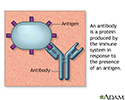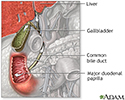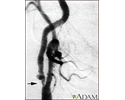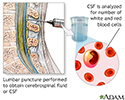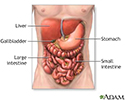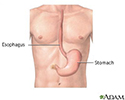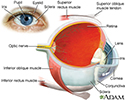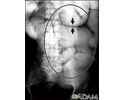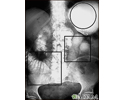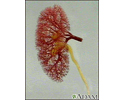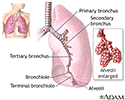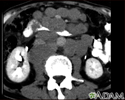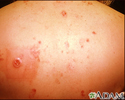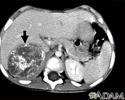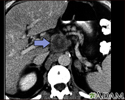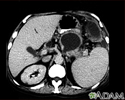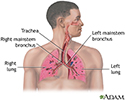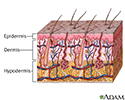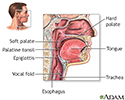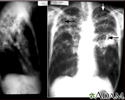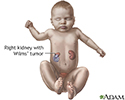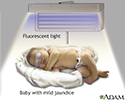Multimedia Gallery
Melanoma
You've noticed a mole, sore, or growth on your skin that doesn't look right. It might be a melanoma and time to see a doctor.
Melanoma is skin cancer caused by changes in cells called melanocytes. These cells make a skin pigment called melanin. Melanin's what gives you your skin and hair color. Melanoma can appear on normal skin, or it may begin as a mole or other area that has changed in appearance. Some moles you have when you're born can develop into melanoma. There are four types: superficial spreading melanoma is the most common. It's usually flat and irregular in shape and color, with different shades of black and brown. It's most common in Caucasians. Nodular melanoma usually starts as a raised area that is dark blackish-blue or maybe bluish-red. Lentigo melanoma usually occurs in older adults. It's more common on sun-damaged skin on your face, neck, and arms. It's usually large, flat, and tan, with areas of brown. Lastly, acral lentigenous melanoma is the least common form. It usually occurs on your palms, soles, or under your nails. And it's more common in African-Americans.
The risk of developing melanoma increases with age, but it is often also seen in young people. You are more likely to get melanoma if you have fair skin, blue or green eyes, or red or blond hair. People who live in sunny climates or at high altitudes are also at risk. As are people who spend a lot of time in the sun, or had one or more blistering sunburns during childhood, or use tanning devices.
So, how do you know you have melanoma?
You may have a mole, sore, lump, or growth on your skin that just doesn't look right. You may notice a sore or growth that bleeds or changes color. One half of the growth may be different from the other. The edges of the growth may be irregular. The color of the growth may change from one area to another. The spot may be larger than 6mm in diameter, about the size of a pencil eraser. The mole may keep changing in appearance.
So, what do you do about melanoma?
To treat melanoma successfully, you have to recognize the symptoms early. Make sure somebody sees all of your skin at least once a year and pay attention to your own skin. Call your doctor if you notice anything unusual.
Your doctor will examine your skin for size, shape, color, and texture of any suspicious areas. If your doctor thinks you may have skin cancer, you'll have a piece of skin removed and sent to a laboratory for testing. This is called a biopsy. You may also have a lymph node biopsy to see if the cancer has spread to nearby lymph nodes. If you are diagnosed with melanoma, you may have other tests to see if the cancer has spread further.
You will need surgery if you have melanoma. The doctor will remove the skin cancer and some of the surrounding tissue. If the cancer has spread to nearby lymph nodes they will also be removed. After surgery, you may need medicine called interferon. If the cancer has spread to organs, it may not be able to be cured. Treatment then might focus on shrinking the cancer and making you as comfortable as possible. You may need chemotherapy, immunotherapy, radiation treatment, and more surgery.
Caught early, some of the types of melanoma can be cured. Melanoma that is very deep or has already spread to lymph nodes is more likely to return after treatment. And the odds are even worse if it has spread farther to other organs. If you have melanoma and recovered, it's important you continue to examine your body for any unusual changes because the cancer may return many years later. One more reason that the earlier you catch it the better.
Melanoma
Review Date: 8/2/2025
Reviewed By: Ramin Fathi, MD, FAAD, Director, Phoenix Surgical Dermatology Group, Phoenix, AZ. Also reviewed by David C. Dugdale, MD, Medical Director, Brenda Conaway, Editorial Director, and the A.D.A.M. Editorial team.
Animations
Illustrations
- 17 week ultrasound
- 30 week ultrasound
- Abdominal organs
- Abdominal quadrants
- Abdominal ultrasound
- Abdominal ultrasound
- Abnormal discharge from the...
- Actinic keratosis - close-up
- Actinic keratosis - ear
- Actinic keratosis on the arm
- Actinic keratosis on the fo...
- Actinic keratosis on the scalp
- Acute lymphocytic leukemia ...
- Acute monocytic leukemia - skin
- Adenocarcinoma
- Adenocarcinoma - chest x-ray
- Adrenal gland biopsy
- Adrenal gland hormone secretion
- Adrenal metastases - CT scan
- Adrenal Tumor - CT
- Aging spots
- Anatomical landmarks adult ...
- Antibodies
- Aortic aneurysm
- Aortic rupture - chest x-ray
- Appendicitis
- Ascites with ovarian cancer...
- Auer rods
- Barium enema
- Barium ingestion
- Basal cell cancer
- Basal Cell Carcinoma - close-up
- Basal cell carcinoma - close-up
- Basal Cell Carcinoma - face
- Basal cell carcinoma - nose
- Basal cell nevus syndrome
- Basal cell nevus syndrome -...
- Basal cell nevus syndrome - face
- Basal cell nevus syndrome -...
- Basal cell nevus syndrome -...
- Basophil (close-up)
- Before and after hematoma repair
- Benign juvenile melanoma
- Benign tumor of the skin
- Bile pathway
- Biopsy catheter
- Bladder biopsy
- Bladder catheterization - female
- Bladder catheterization - male
- Blood cells
- Blood test
- Bone biopsy
- Bone density scan
- Bone marrow aspiration
- Bone marrow from hip
- Bowen's disease on the hand
- BPH
- Brain
- Brain wave monitor
- Brain-thyroid link
- Breast lumps
- Breast pain
- Breast self-exam
- Breast self-exam
- Breast self-exam
- Bronchial cancer - chest x-ray
- Bronchial cancer - CT scan
- Bronchoscope
- Bronchoscopy
- Bronchoscopy
- Burns
- Calculating body frame size
- Candida - fluorescent stain
- Candidal esophagitis
- Canker sore (aphthous ulcer)
- Carotid duplex
- Carotid stenosis - X-ray of...
- Carotid stenosis - X-ray of...
- Carpal biopsy
- Carpal tunnel syndrome
- Causes of breast lumps
- Causes of breast lumps
- Central nervous system and ...
- Cervical biopsy
- Cervical cancer
- Cervical cancer
- Cervical cryosurgery
- Cervical cryosurgery
- Cervical neoplasia
- Cervical polyps
- Changes in face with age
- Changes in lung tissue with age
- Changes in skin with age
- Cheilitis - actinic
- Child thyroid anatomy
- Cholesterol producers
- Chromosomes and DNA
- Chronic lymphocytic leukemi...
- Chronic myelocytic leukemia
- Chronic myelocytic leukemia
- Chronic myelocytic leukemia...
- Cirrhosis of the liver
- Clubbing
- Coal worker's lungs - chest...
- Coal workers pneumoconiosis...
- Coal workers pneumoconiosis...
- Coal workers pneumoconiosis...
- Coal workers pneumoconiosis...
- Coccidioidomycosis - chest x-ray
- Cold cone biopsy
- Cold cone removal
- Colon culture
- Colonoscopy
- Colonoscopy
- Colposcopy-directed biopsy
- Congenital nevus on the abdomen
- Cryoglobulinemia of the fingers
- CSF cell count
- CSF protein test
- CT scan
- Cystography
- Cystoscopy
- Diet and disease prevention
- Digestive system
- Digestive system organs
- Donor liver attachment
- Emphysema
- Endocrine glands
- Endometrial biopsy
- Endometrial biopsy
- Endometrial cancer
- Enlarged spleen
- Epithelial cells
- ERCP
- ERCP
- Esophagus and stomach anatomy
- Ewing sarcoma - x-ray
- Eye
- Facial drooping
- Fat tissue biopsy
- Fatty liver - CT scan
- Fecal occult blood test
- Female breast
- Female breast biopsy
- Female perineal anatomy
- Female reproductive anatomy
- Female reproductive anatomy
- Female urinary tract
- Fibroadenoma
- Fibrocystic breast change
- Fibroid tumors
- Formed elements of blood
- Gallbladder anatomy
- Gallbladder endoscopy
- Gallium injection
- Gallstones
- Gallstones, cholangiogram
- Gum biopsy
- Hairy cell leukemia - micro...
- Half and half nails
- Hand X-ray
- Head and neck glands
- Headache
- Heart - front view
- Heart - section through the...
- Heartburn prevention
- Hemangioma - angiogram
- Hemangioma - CT scan
- Hemoglobin
- Hemorrhoids
- Hepatocellular cancer - CT scan
- Hepatomegaly
- Hodgkin's disease - liver i...
- Hydrocele
- Hysterectomy
- Ileus - x-ray of bowel dist...
- Ileus - x-ray of distended ...
- Immune system structures
- Incision for lung biopsy
- Incision for pleural tissue...
- Incision for thyroid gland ...
- Intraductal papilloma
- Intravenous pyelogram
- Intussusception - x-ray
- Jaundice
- Jaundiced infant
- Kaposi sarcoma - close-up
- Kaposi sarcoma - lesion on ...
- Kaposi sarcoma - perianal
- Kaposi sarcoma on foot
- Kaposi sarcoma on the back
- Kaposi's sarcoma on the thigh
- Keratoacanthoma
- Keratoacanthoma
- Kidney - blood and urine flow
- Kidney anatomy
- Kidney function
- Kidney function tests
- Kidney metastases - CT scan
- Kidney tumor - CT scan
- Kidneys
- Koilonychia
- Large intestine (colon)
- Large intestine anatomy
- Lentigo - solar on the back
- Lentigo - solar with erythe...
- Leucine aminopeptidase urin...
- Lichen planus on the oral mucosa
- Lipoma - arm
- Liver biopsy
- Liver cirrhosis - CT scan
- Liver function tests
- Liver metastases, CT scan
- Liver with disproportional ...
- Lobes of the brain
- Lower digestive anatomy
- Lumpectomy
- Lung biopsy
- Lung cancer - chemotherapy ...
- Lung cancer - frontal chest...
- Lung cancer - lateral chest...
- Lung mass, right lung - CT scan
- Lung mass, right upper lobe...
- Lung mass, right upper lung...
- Lung nodule - front view ch...
- Lung nodule, right lower lu...
- Lung nodule, right middle l...
- Lung tissue biopsy
- Lung with squamous cell can...
- Lungs
- Lymph node metastases, CT scan
- Lymphangiogram
- Lymphatic system
- Lymphoma, malignant - CT scan
- Malaria, microscopic view o...
- Malaria, photomicrograph of...
- Male reproductive anatomy
- Male reproductive system
- Male urinary system
- Male urinary tract
- Malignancy
- Malignant melanoma
- Malignant teratoma
- Mammary gland
- Mammogram
- Mammography
- Mediastinoscopy
- Megaloblastic anemia - view...
- Melanoma
- Melanoma - neck
- Melanoma of the liver - MRI scan
- MIBG injection
- Mongolian blue spots
- Mouth anatomy
- Mouth sores
- MRI scans
- Multiple basal cell cancer ...
- Muscle biopsy
- Nail infection - candidal
- Nasal biopsy
- Neck lump
- Needle biopsy of the breast
- Nerve biopsy
- Neuroblastoma in the liver ...
- Neurofibromatosis I - enlar...
- Non-small cell carcinoma
- Normal external abdomen
- Normal female breast anatomy
- Normal lung anatomy
- Normal lungs and alveoli
- Normal uterine anatomy (cut...
- Onycholysis
- Open biopsy of the breast
- Oral anatomy
- Oral thrush
- Oropharyngeal biopsy
- Oropharynx
- Osteogenic sarcoma - x-ray
- Osteoporosis
- Osteoporosis
- Osteoporosis
- Ovalocytosis
- Ovarian cancer
- Ovarian cancer dangers
- Ovarian cancer metastasis
- Ovarian cyst
- Ovarian cysts
- Ovarian growth worries
- Pancreas
- Pancreatic cancer, CT scan
- Pancreatic pseudocyst - CT scan
- Pancreatic, cystic adenoma ...
- Pap smear
- Pap smear
- Pap smears and cervical cancer
- Parathyroid biopsy
- Pelvic adhesions
- Pelvic laparoscopy
- Peritoneal and ovarian canc...
- Physical activity - prevent...
- Phytochemicals
- Pleural biopsy
- Pleural cavity
- Pleural smear
- Pleural space
- Primary and secondary hypot...
- Primary brain tumor
- Prostate cancer
- Prostate cancer
- Prostate gland
- PSA blood test
- Ptosis - drooping of the eyelid
- Pulmonary mass - side view ...
- Pulmonary nodule - front vi...
- Pulmonary nodule, solitary ...
- Quitting smoking
- Radiation therapy
- Rectal biopsy
- Rectal cancer - x-ray
- Red blood cells - elliptocytosis
- Red blood cells - multiple ...
- Red blood cells - normal
- Red blood cells - sickle an...
- Red blood cells - sickle cells
- Red blood cells - spherocytosis
- Red blood cells, sickle cell
- Red blood cells, target cells
- Red blood cells, tear-drop shape
- Renal biopsy
- Respiratory cilia
- Respiratory system
- Retina
- Salivary gland biopsy
- Sarcoid, stage II - chest x-ray
- Sarcoid, stage IV - chest x-ray
- Scrotal mass
- Secondhand smoke and lung cancer
- Selenium - antioxidant
- Sentinel node biopsy
- Serotonin uptake
- Sigmoid colon cancer - x-ray
- Sinuses
- Skeletal spine
- Skeleton
- Skeleton (posterior view)
- Skin
- Skin cancer - close-up of l...
- Skin cancer - close-up of l...
- Skin cancer - malignant melanoma
- Skin cancer - melanoma supe...
- Skin cancer - raised multi-...
- Skin cancer - squamous cell...
- Skin cancer, basal cell car...
- Skin cancer, basal cell car...
- Skin cancer, basal cell car...
- Skin cancer, basal cell car...
- Skin cancer, close-up of le...
- Skin cancer, melanoma - fla...
- Skin cancer, melanoma - rai...
- Skin cancer, melanoma on th...
- Skin cancer, squamous cell ...
- Skin layers
- Skull of an adult
- Small bowel obstruction - x-ray
- Small cell carcinoma
- Small intestine
- Small intestine biopsy
- Smoking hazards
- Smoking hazards
- Spermatocele
- Spinal tumor
- Spleen and liver metastases...
- Splenomegaly
- Squamous cell cancer
- Squamous cell carcinoma
- Squamous cell carcinoma - i...
- Stages of cancer
- Sternum - view of the outsi...
- Stomach
- Stomach cancer, x-ray
- Stomach ulcer, x-ray
- Structure of the colon
- Sun protection
- Sunburn
- Sunburn
- Sunburn
- Superficial anterior muscles
- Surface anatomy - normal palm
- Surface anatomy - normal wrist
- Swollen lymph nodes in the groin
- Swollen lymph nodes under arm
- Synovial biopsy
- Temperature measurement
- Teratoma - MRI scan
- Testicular anatomy
- Testicular biopsy
- Testicular ultrasound
- The large intestine
- Thermometer temperature
- Throat anatomy
- Thyroid cancer - CT scan
- Thyroid cancer - CT scan
- Thyroid enlargement - scintiscan
- Thyroid gland
- Thyroid gland biopsy
- Thyroid ultrasound
- Tobacco and cancer
- Tobacco and chemicals
- Tobacco and vascular disease
- Tobacco health risks
- Tongue
- Tongue biopsy
- Tooth anatomy
- Tuberculosis, advanced - ch...
- Ultrasound
- Ultrasound comparison
- Ultrasound in pregnancy
- Ultrasound, normal fetus - ...
- Upper airway test
- Upper gastrointestinal system
- Ureteral biopsy
- Urine test
- Uterine anatomy
- Uterus
- Vertebra, thoracic (mid back)
- Vertebrae
- Viral lesion culture
- Visual acuity test
- Visual field test
- Vitamin B3 source
- Vitamin B6 benefit
- Vitamin C benefit
- Volvulus - x-ray
- Waldenström
- Wart (verruca) with a cutan...
- Warts - flat on the cheek a...
- Warts, multiple - on hands
- White nail syndrome
- Wilms tumor
- X-ray
- Yellow nail syndrome
- Yellow nails
Presentations
- Biliary obstruction - series
- Breast lump removal - series
- Colon cancer - series
- Colostomy - series
- Exchange transfusion - series
- Gastrectomy - series
- Hemorrhoid surgery - series
- Hysterectomy - Series
- Large bowel resection - series
- Mastectomy - series
- Prostatectomy - Series
- Pulmonary lobectomy - series
- Small bowel resection - series
- Spleen removal - series
- Transurethral resection of ...

 Bookmark
Bookmark









































